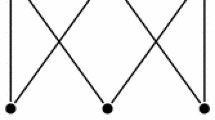Abstract
A community faces the obligation of providing an indivisible public good that each of its members is able to provide at a certain cost. The solution is to rely on the member who can provide the public good at the lowest cost, with a due compensation from the other members. This problem has been studied in a non-cooperative setting by Kleindorfer and Sertel (J Econ Theory 64:20–34, 1994). They propose an auction mechanism that results in an interval of possible individual contributions whose lower bound is the equal division. Here, instead we take a cooperative stand point by modelling this problem as a cost sharing game that turns out to be a ‘reverse’ airport game whose core is shown to have a regular structure. This enables an easy calculation of the nucleolus that happens to define the upper bound of the Kleindorfer–Sertel interval. The Shapley value instead is not an appropriate solution in this context because it may imply compensations to non-providers.
Similar content being viewed by others
References
Dehez P. (2011) The allocation of fixed costs and the weighted Shapley value. International Game Theory Review 13: 1–16
Dehez, P., & Tellone, D. (2012). Data games. Sharing the cost of public goods with exclusion. Revised CORE discussion paper 2008-10, to appear in Journal of Public Economic Theory.
Driessen T. (1985) Properties of 1-convex n-person games. OR Spectrum 7: 19–26
Faulhaber G. (1975) Cross-subsidization: Pricing in public enterprises. American Economic Review 65: 966–977
Gillies, D. B. (1953). Some theorems on n-person games. PhD Thesis. University of Princeton.
Gonzáles-Díaz J., Sánchez-Rodríguez E. (2007) A natural selection from the core of a TU game: The core-centre. International Journal of Game Theory 36: 27–46
Grünbaum B. (2003) Convex polytopes (2nd ed.). Springer, Berlin
Kleindorfer P., Sertel M. (1994) Auctioning the provision of an indivisible public good. Journal of Economic Theory 64: 20–34
Kunreuther H., Kleindorfer P., Knetz P.J., Yaksick R. (1987) A compensation mechanism for siting noxious facilities: Theory and experimental design. Journal of Environmental Economics and Management 14: 371–383
Littlechild S.C., Owen G. (1973) A simple expression for the Shapley value in a special case. Management Science 20: 370–372
Maschler M., Peleg B., Shapley L.S. (1979) Geometric properties of the kernel, nucleolus and related solution concepts. Mathematics of Operations Research 4: 303–338
Schmeidler D. (1969) The nucleolus of a characteristic function game. SIAM Journal of Applied Mathematics 17: 1163–1170
Shapley L.S. (1953) A value for n-person games. In: Kuhn H., Tucker A.W. (eds) Contributions to the Theory of Games II. Princeton University Press, Princeton, pp 307–317
Thomson, W. (2007). Airport problems and cost allocation. Rochester Center for Economic Research Working Paper.
Young P.Y. (1985) Cost allocation: Methods, principles, application. North-Holland, Amsterdam
Author information
Authors and Affiliations
Corresponding author
Rights and permissions
About this article
Cite this article
Dehez, P. Cooperative provision of indivisible public goods. Theory Decis 74, 13–29 (2013). https://doi.org/10.1007/s11238-012-9311-x
Published:
Issue Date:
DOI: https://doi.org/10.1007/s11238-012-9311-x




